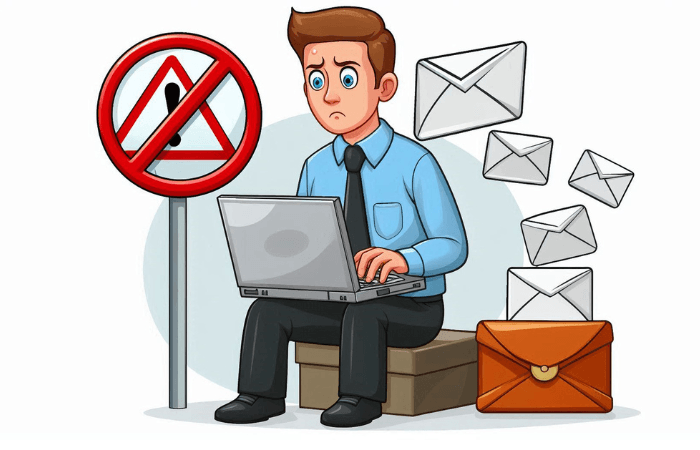What is Cold Emailing?
Cold emailing is when you send an email to someone you don’t know yet, like a stranger or a business you haven’t talked to before. It’s different from spam because spam emails are usually sent in bulk and don’t really connect with the person receiving them. Cold emails, on the other hand, are often written to be more personal and specific to the person you’re reaching out to.
People and businesses use cold emailing to find new clients, network with others in their industry, or share information about their products or services. It’s a popular way to make connections in today’s digital world. If you want to do cold emailing well, you need to think about what you want to say and how to say it. A good cold email should feel friendly and genuine, making the recipient interested in responding or learning more.

Simple Steps for Writing Your Cold Email
Cold emailing can be a helpful way to connect with new people, whether you want to introduce yourself, share an idea, or suggest a partnership. A well-written cold email can create new opportunities. However, it’s important to approach it carefully to improve your chances of getting a reply. In the following steps, we will go over the key things to think about when writing your cold email. This will help your message stand out and resonate with the person you are contacting.
Step 1: Know What You Want
Before you start writing your email, think about what you want to achieve. What’s the goal of this email? Are you looking to find new customers, set up a time to chat, promote something cool you have, or just connect with someone? Knowing what you want will help you write a clearer message. It’s kind of like planning a trip—you wouldn’t leave home without knowing where you’re headed, right? So, take a moment to figure out your goal before you start writing!
Step 2: Learn About the Person You’re Emailing
Next, spend some time getting to know the person or company you’re reaching out to. It’s really important to understand your audience. Check out their job title, the company they work for, and what kind of industry they’re in. Think about the problems they might have and how what you offer could help them out. Also, look for things you might have in common that could help you connect. You can use LinkedIn, company websites, and even social media to gather this info. The more you know, the better you can write your email.
Step 3: Write a Catchy Subject Line
The subject line is the first thing they’ll see, so make it catchy but simple. You want it to grab their attention without being too formal. Something like “Quick note for you” or “Check this out—it could be helpful!” works well. A good subject line makes them want to open your email and see what you’re saying.
Step 4: Start with a Friendly Greeting
Once they open your email, start off with a friendly greeting and something personal. You can mention a mutual connection, a recent post they made, or anything else that shows you’ve taken the time to learn a bit about them. For example, you might say, “Hey [Name], I saw your recent post about [Topic], and it really caught my eye! I thought it was super interesting, and I’d love to chat more about it!” This kind of opening helps you come across as genuine and makes it easier to connect.
Step 5: Tell Them How You Can Help
After your friendly intro, get to the point about how you can help them. Keep it simple and straightforward. You don’t want to use any fancy language that might confuse them. You could say something like, “I noticed you’re working on [specific project]. That sounds awesome! I’ve helped others with similar projects, and I have some ideas that might really help you out. I’d love to share those with you!” This makes it clear that you’re reaching out to offer something useful without being pushy.
Step 6: Ask for a Response
Finally, finish your email with a clear next step. Tell them what you’d like them to do after reading your email. Whether you want them to set up a meeting, reply with their thoughts, or check out your website, make it easy for them. You could say something like, “Do you have time for a quick chat next week? I’d really like to hear your thoughts and see how we can work together.”
Step 7: Keep It Short and Simple
When you’re writing your email, it’s super important to respect the other person’s time. Everyone gets a lot of emails, and long, wordy ones can be overwhelming. So, try to keep your email short and to the point. Aim for a few short paragraphs that are easy to read. If you have a lot of information, think about using bullet points. This way, you break up the text and make it easier for them to scan through quickly. The idea is to get your message across without dragging it out.
Step 8: Add Your Signature
At the end of your email, don’t forget to include your email signature. This is basically a little sign-off that tells the recipient who you are. Make sure to add your name, your job title, the name of your company, and your contact info like your phone number or website. A signature adds a nice touch of professionalism and makes it easy for the person to get in touch with you if they want to. Plus, it gives them a chance to learn a bit more about you and your role.
Step 9: Follow Up
Sometimes, people get busy and might not reply to your email right away. If you haven’t heard back after about a week, don’t worry! It’s totally okay to send a follow-up email. Just keep it friendly and polite. You can gently remind them of your previous email and ask if they had a chance to think about it. For instance, you might say, “Hi [Name], I hope you’re doing well! I just wanted to check in and see if you saw my last email. I’d really love to hear your thoughts on it!” This way, you’re giving them a little nudge without being pushy.
Step 10: Look at the Results
After you’ve sent out your cold emails, take some time to see how they’re performing. This means checking things like how many people opened your email, how many replied, and if anyone took the action you were hoping for. There are tools like Google Analytics or email tracking software that can help you with this. Analyzing the results will give you a better idea of what’s working and what might need some tweaking. Maybe certain subject lines got more attention, or maybe people responded better to a specific call to action. The more you look at the data, the better you can refine your approach for next time.
Precautions to Take While Sending Cold Emails

Before you start sending cold emails, it’s important to keep a few things in mind. Cold emailing can help you connect with new people. However, you need to approach it carefully, as many emails end up in spam. If you want to avoid having your messages marked as spam, consider taking these precautions:
1. Create an Eye-Catching Subject Line
A good subject line is like the headline of a news article—it needs to grab attention. Think about what would make you want to open an email. Try to keep it short and sweet while still letting the recipient know what to expect. Avoid using all caps or too many exclamation points, as those can make your email look spammy. Instead, use simple language that conveys your message clearly. For example, instead of “Great Opportunity Just for You!!!” try something like “Quick Question About Your Recent Project.” This way, the recipient knows you’re reaching out for a reason.
2. Make Your Email Personal
Personalizing your email can make a huge difference in how someone responds. Instead of sending a generic message to everyone, take a moment to learn a bit about the person you’re emailing. Use their name in the greeting, and mention something specific about their work or interests. For example, you could say, “I really enjoyed your recent article on marketing strategies.” This shows that you’re genuinely interested in them and not just sending out a mass email. A little bit of effort can go a long way in building a connection!
3. Keep it Professional and Respectful
When you’re reaching out to someone for the first time, it’s important to maintain a professional tone. This means using proper grammar and avoiding slang or overly casual language. You want to come across as respectful and serious about your inquiry. Also, be mindful of the recipient’s time. Keep your email brief and to the point, focusing on what you want to communicate without unnecessary fluff. A polite, respectful email is more likely to get a positive response.
4. Make Sure Your Email is Set Up Correctly
To ensure your emails end up in the recipient’s inbox rather than their spam folder, it’s important to have a few technical things in place. Here’s what you should do:
a) Set Up SPF: SPF (Sender Policy Framework) helps email providers verify that your emails are coming from an authorized source. By setting this up, you’re basically saying, “Hey, these emails are really from me!” This helps prevent someone else from pretending to be you.
b) Use DKIM: DKIM (DomainKeys Identified Mail) adds a special digital signature to your emails. This signature acts like a security seal, allowing the recipient to check that the email hasn’t been tampered with on its way to them. It reassures them that it genuinely comes from you.
c) Set Up DMARC: DMARC (Domain-based Message Authentication, Reporting & Conformance) is a tool that helps protect your domain from being used for scams. It tells email servers what to do if your email doesn’t pass the SPF or DKIM checks. Plus, it provides reports on how your emails are being handled, which is super helpful.
d) Check MX Records: MX records are like the address for your email server. They direct where emails should be sent. It’s important to make sure these records are set up correctly, especially if you switch email providers. If they’re not right, your emails might not get delivered at all.
5. Don’t Be Afraid to Follow Up
If you don’t hear back after your initial email, it’s okay to send a polite follow-up. Sometimes emails get lost in the shuffle, and a gentle reminder can be helpful. Wait about a week before reaching out again. In your follow-up, keep it friendly and express your continued interest. For example, you might say, “I wanted to check in to see if you had a chance to look at my previous email. I’d love to hear your thoughts!” This shows that you’re still interested without being pushy.
6. Follow the Rules for Sending Emails
It’s crucial to be aware of the laws regarding email communications, such as the CAN-SPAM Act in the U.S. and GDPR in Europe. These laws are designed to protect consumers from unwanted emails. Always give recipients the option to unsubscribe from your emails easily. This not only keeps you compliant with regulations but also shows respect for their preferences. Ignoring these rules can lead to penalties and harm your reputation, so it’s best to stay informed and follow the guideline.
In conclusion, cold emailing is a great way to connect with new people and explore opportunities. If you take your time and think about how you reach out, your messages can be more meaningful. Always remember to personalize your emails. It’s also important to respect people’s privacy and follow the rules. These steps can help you get better results and build strong relationships through your cold emails.




